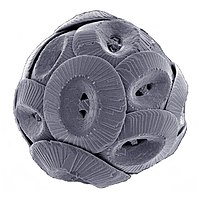
Photo from wikipedia
Abstract The sequestration of algal organic matter (AOM) in clays constitute important carbon sinks in lake sediments. The composition of AOM was proven recently to critically influence its preservation in… Click to show full abstract
Abstract The sequestration of algal organic matter (AOM) in clays constitute important carbon sinks in lake sediments. The composition of AOM was proven recently to critically influence its preservation in sediments. Yet it remains unclear which AOM components and types of clay minerals contribute to AOM burial in lake sediments. Here we investigated the AOM fractionation in kaolinite and illite via their adsorption, to ascertain the distribution of AOM components on these clay surfaces. The results showed that the AOM adsorbed quantity was 2-fold higher for illite than kaolinite. The adsorption isotherm data of illite and kaolinite were well fitted by a Freundlich model. The three-dimensional excitation emission matrix fluorescence spectroscopy (3D EEM) with parallel factor analysis (PARAFAC) modeling identified the AOM component under fractionation. The AOM solution mainly consisted of humic acid-like, tyrosine-like, and tryptophan-like components. Notably, large amounts of the hydrophilic tyrosine-like components were adsorbed onto the surface of both kaolinite and illite, whereas the hydrophobic tryptophan-like components were seldom adsorbed onto neither of the clay materials, while humic acid-like components were only adsorbed onto illite. Therefore, illite is more suitable for the preservation of AOM. Both transmission electron microscopy-energy dispersive X-ray spectroscopy (TEM-EDS) and the X-ray photoelectron spectroscopy (XPS) analysis further confirmed the high adsorption of AOM on the surface of illite; i.e., the molar content of carbon in AOM adsorbed to illite was 22.04%, almost a double of that adsorbed to kaolinite (11.59%). Overall, our results demonstrate the selective preservation of AOM on clay surfaces and highlight the role of clay minerals as sequesters of organic matter in eutrophic lakes.
Journal Title: Applied Clay Science
Year Published: 2021
Link to full text (if available)
Share on Social Media: Sign Up to like & get
recommendations!